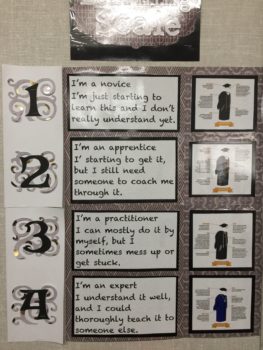What Does an Engaged Classroom Look Like?
 What Does an Engaged Classroom Look Like?
What Does an Engaged Classroom Look Like?
This post is sixth of a series based on excepts from my book on Student-Engaged Assessment: Strategies to Empower All Learners by Laura Greenstein and Mary Ann Burke (2020). You can purchase the book from Roman and Littlefield for charts, examples, and worksheets on how to engage students to become owners of their learning successes.
How to Create Learning Goals from Academic Standards
In the classroom, clear and actionable goals are a good start to supporting student learning. Students can then deconstruct standards and big picture goals into their own individual learning aims and intentions. The level of challenge must be feasible for the students. If the goals are too easy, students will get bored and complete their assignment quickly. If the goals are too hard, students become discouraged leading to low-quality outcomes, or none at all.
Students’ Feedback Ensures Realistic Learning Goals
Feedback is also an essential element of flow. This can be personal feedback through reflection on progress and outcomes, a self-scored rubric, and feedback from a peer or from a teacher. Students’ statements of engagement include:
- “I understand the learning intentions and I’m supposed to…”
- “Now I know where and why we are heading there.”
- “I know what I will do to reach them: read, highlight, and color code the categories.”
- “I will start with this first step and see how it works out.”
- “I can make progress. I’ll take my time reading to see if I can understand the main ideas.”
- “OK, the first step is done and I checked it against the criteria. I just need to adjust the tone.”
- “This sounds interesting AND possible. I have strong feelings on this topic and will try to curb my emotions.”
- “OK, I’ll give it another try. Now that I can see where I’m headed.”
Engaging learners in assessment reduces the stress of learning something new. A little cortisol, the stress hormone, can whet the brain in anticipation of an assessment, but we don’t want to raise it to a red flag level. Finding the balance between attentiveness and anxiety differs from student to student. In any setting, there should be no assessment surprises. For example, asking students to apply learning in a somewhat different scenario than the one learned in class can raise anxiety and students should be reassured that the process is the same. Stress from notetaking can be reduced by giving students empty outlines where they are picking out the appropriate word or phrase. Confidence in public speaking can be developed through the use of students’ choice of a technology for electronic presentations.
Student Engagement Ensures Informative Feedback
Engagement is infrequently an element of traditional assessment as tests are typically a solo activity. But when the roots of assessment are considered, the connections become clearer. Assessment comes from the Latin word “assidere” which means “to sit beside as an assistant or advisor.” These routine check-ins, informative feedback, and opportunities for improvement are the engaging and relationship-based elements of assessment.
Sarine prefers predictability in assessment and Seiji sees himself as an assessment warrior. Sarine has learned the skills she needs to purposefully and diligently prepare for an upcoming test. She summarizes the main ideas, reviews what she was taught about its meaning and relevance, and how it was used in class. She confidently digs into the example on the test. Seiji has a momentary panic attack before realizing that they did a similar problem in class and the flow of cortisol activates his brain enabling him to do his best work.
What Is a SMART GOAL?
There are numerous goal setting models. The SMART goal model shown is a reliable and achievable strategy for students. It is an acronym for Specific, Measurable, Attainable, Relevant, and Time-Based. The model is relevant for all learners by adjusting the language levels. For example, “What are my specific goals?” is simplified to “This is what I will learn. What actions and steps will I take?” translates to “My first step will be.”
Personalization of goals makes them more relevant, authentic, and interesting to learners. It begins when students evaluate their incoming knowledge and skills in relation to learning purposes and intentions and in due course, to assess their learning outcomes. Here is a summary of steps students must consider in creating SMART goals:
- Students must consider what they need to learn to establish specific and strategic
- They must identify any qualitative or quantitative data that is required to create measurable and motivational
- Goals must realistic with steps and a timeline to be actionable and achievable.
- Students can monitor the steps to achieve time-based and tangible
Our December 14th blog will provide an example and explain how students assess their learning outcomes. For more charts, examples, and worksheets on how to engage students to own their learning, you can purchase Student-Engaged Assessment: Strategies to Empower All Learners by Laura Greenstein and Mary Ann Burke (2020) from Roman and Littlefield